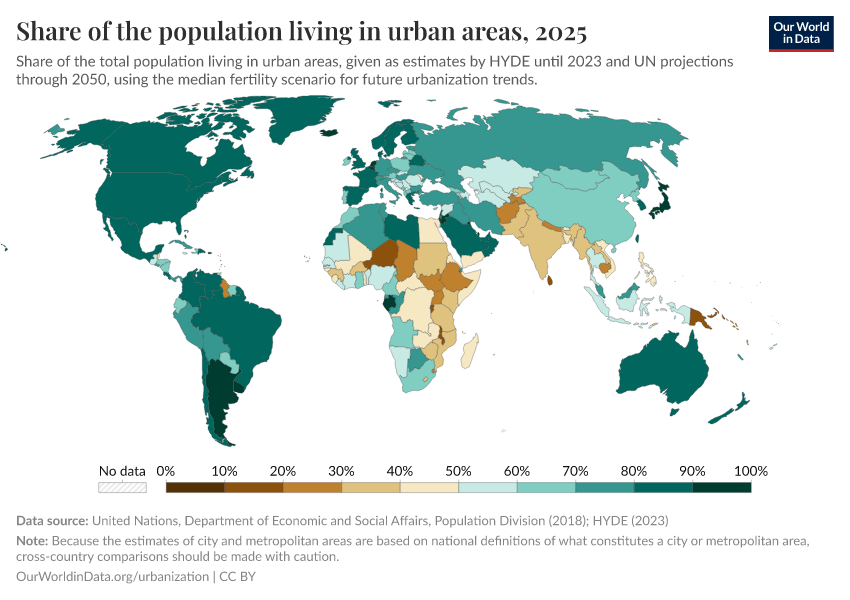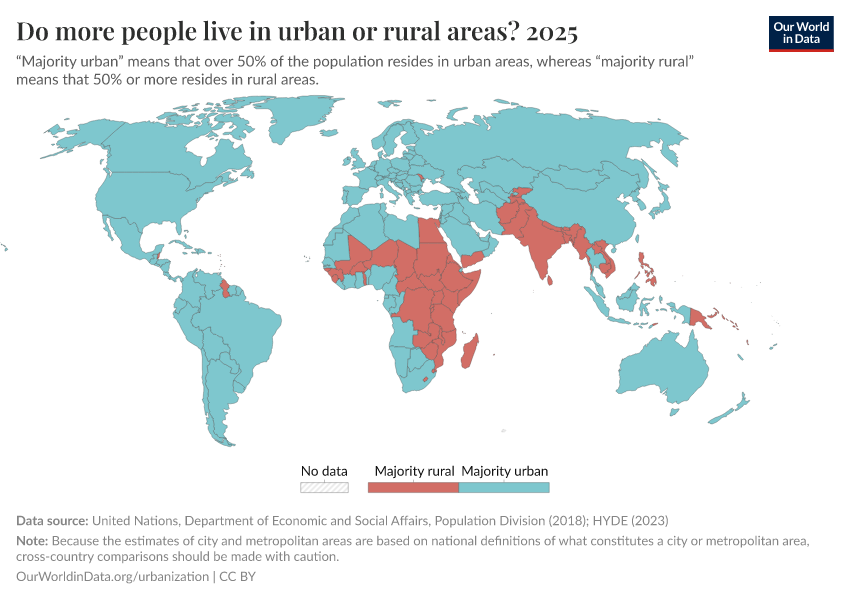Share of population residing in urban areas

What you should know about this indicator
The projection method for urban population in the World Urbanization Prospects involves a two-step process using an established extrapolation method based on urban-rural ratios. Initially, the average annual rate of change in the urban-rural ratio is calculated using data from the last two censuses, which informs the rate of change in urban and rural populations. This rate is then extrapolated, assuming a logistic path of urban proportion growth. Subsequently, a "world norm" is applied, estimated from empirical urban-rural growth differences in two groups of countries categorized by population size. This norm uses a regression equation to establish a hypothetical urban-rural growth difference for different levels of initial urban percentage.
The country-specific urban-rural growth difference is then converged with this hypothetical difference over 25 years, allowing the urbanization process of a country to align with a global urbanization pattern. This method ensures that urban-rural growth differences evolve towards a worldwide trend rather than remaining constant.
Related research and writing
Sources and processing
This data is based on the following sources
How we process data at Our World in Data
All data and visualizations on Our World in Data rely on data sourced from one or several original data providers. Preparing this original data involves several processing steps. Depending on the data, this can include standardizing country names and world region definitions, converting units, calculating derived indicators such as per capita measures, as well as adding or adapting metadata such as the name or the description given to an indicator.
At the link below you can find a detailed description of the structure of our data pipeline, including links to all the code used to prepare data across Our World in Data.
Reuse this work
- All data produced by third-party providers and made available by Our World in Data are subject to the license terms from the original providers. Our work would not be possible without the data providers we rely on, so we ask you to always cite them appropriately (see below). This is crucial to allow data providers to continue doing their work, enhancing, maintaining and updating valuable data.
- All data, visualizations, and code produced by Our World in Data are completely open access under the Creative Commons BY license. You have the permission to use, distribute, and reproduce these in any medium, provided the source and authors are credited.
Citations
How to cite this page
To cite this page overall, including any descriptions, FAQs or explanations of the data authored by Our World in Data, please use the following citation:
“Data Page: Share of population residing in urban areas”, part of the following publication: Hannah Ritchie, Veronika Samborska and Max Roser (2024) - “Urbanization”. Data adapted from United Nations, Department of Economic and Social Affairs, Population Division, PBL Netherlands Environmental Assessment Agency. Retrieved from https://ourworldindata.org/grapher/urban-population-share-2050 [online resource]How to cite this data
In-line citationIf you have limited space (e.g. in data visualizations), you can use this abbreviated in-line citation:
United Nations, Department of Economic and Social Affairs, Population Division (2018); HYDE (2023) – with minor processing by Our World in DataFull citation
United Nations, Department of Economic and Social Affairs, Population Division (2018); HYDE (2023) – with minor processing by Our World in Data. “Share of population residing in urban areas” [dataset]. United Nations, Department of Economic and Social Affairs, Population Division, “World Urbanization Prospects Dataset”; PBL Netherlands Environmental Assessment Agency, “History Database of the Global Environment 3.3” [original data]. Retrieved March 11, 2025 from https://ourworldindata.org/grapher/urban-population-share-2050